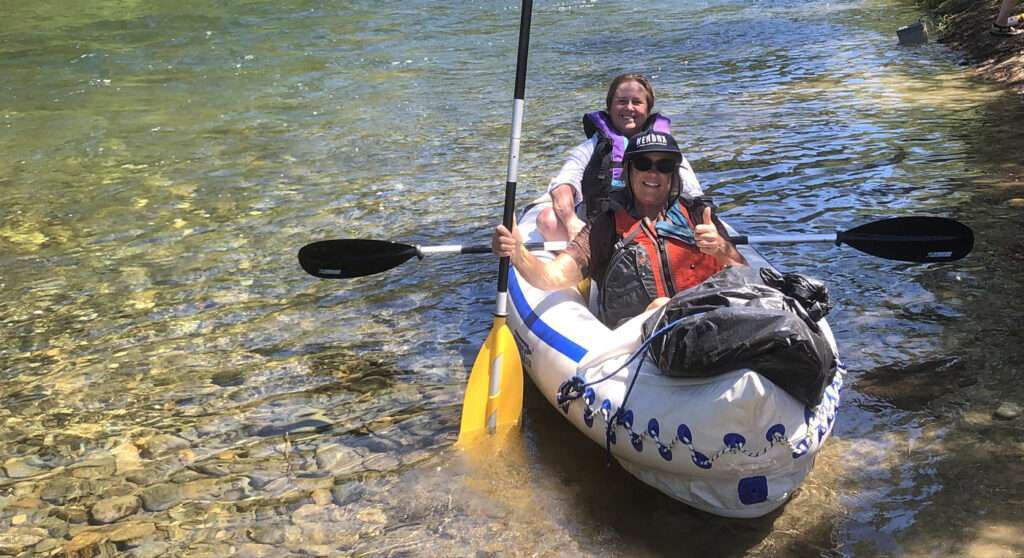Kayaking is a thrilling, and popular activity in some parts of the world. It involves paddling on water while sitting in a kayak. Kayaks can be used for many things aside from just recreation – they are also great for transportation or even safety equipment during low visibility conditions like foggy mornings. The kayak itself is an excellent vessel to travel across open water with ease and speed, as well as cross rivers that would otherwise require portages or ferries to reach the other side.
The question remains though: “Should I go kayaking if I don’t know how to swim?”
Start Kayaking in Slow Moving River or in A lake
The first thing to remember when kayaking is that you should always consider the water conditions. If it’s a slow-moving river, then this might be an option for beginners who don’t know how to swim or have never kayaked before. However, if it becomes turbulent and choppy with waves (unlikely in a river), your best bet would be to head over towards flat calm waters like lakes where you will not face too many challenges paddling around and enjoying your time on the water.
With these two options available depending of what type of environment you’re comfortable kayaking in, as well as whether or not there are other people nearby who can assist if something goes wrong .
Try Winning Over Fear
You need to get yourself familiarized with water. You can do this by taking kayaking lessons or joining a group that does kayaking on the weekends. It’s not like you’re going to need an expert level of skills before heading out, but it will help if you know how to hold onto the paddle properly and work with your partner when someone falls off their boat.
Don’t be afraid – just try! Don’t allow the panic to set in just because the kayak has capsized. You need to get yourself mentally trained.
The best way to do this is through practice. Practice on a lake or in an area where there isn’t any danger if you capsize your kayak, and it’ll be easier when you are finally out on the water.
You should also know how to use a pump if something does happen and your kayak has capsized. The more experience with being near water that you get, the less anxious it will make you feel just being around it.
Always Wear Life Vest While Kayaking
Put on a good quality personal floatation device. This will help you stay afloat in the case something untoward happens. PFDs, or personal flotation devices are designed to give you that extra safety measure in the water. Even if you don’t know how to swim (like me), a PFD will help keep your head above water and easily safe when falling out of kayak, which can happen all too often! It’s also really important however that you buy one with good quality before heading into the great blue yonder because they come in so many different shapes and sizes now-a-days it might be hard finding something comfortable for long periods without wasting time overthinking things.
Get Trained First
You need to pay a visit to a kayak trainer first and learn about the safety measures you need to take before even considering kayaking. Remember, no one can save you but yourself!
Kayak trainers will show you how to operate a kayak correctly so that if anything does happen, it won’t be as bad. They’ll also teach you what do in case of emergencies and crash landings – which unfortunately are all too common for beginners like me who don’t know much about kayaking yet. The best thing is that they’re pretty inexpensive nowadays so prices shouldn’t stop anyone with adventurous spirit from taking up this sport after getting trained first on how to go kayaking without drowning or crashing into things wrongly and hurting themselves badly enough where their trip ends prematurely because they needed emergency medical attention.
You should try to gather as much information about sweep roll and wet water exit techniques as possible.
Conclusion
Kayaking is a great sport for people who don’t know how to swim. You can learn about kayaking safety, and then you’ll be able to do it with confidence. There are lots of videos on youtube that teach you the basics so all you have to do is search what’s called “how-to” kayak techniques or some other related term if you’re not sure what I’m talking about. The best part though? Kayaks are pretty inexpensive nowadays too! That means anyone who has an adventurous spirit should try their hand at this new adventure after training first on how to go kayaking without drowning or crashing into things wrongly and hurting themselves badly enough where their trip ends prematurely because they needed emergency medical attention.

